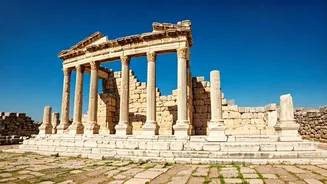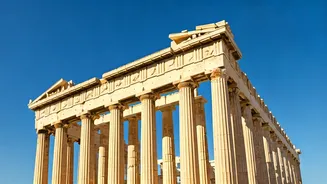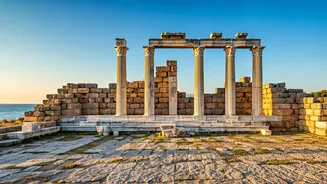The Acropolis of Athens
Dominating the Athenian skyline, the Acropolis is more than just a collection of ancient buildings; it's a symbol of democracy, philosophy, and art. The
Parthenon, dedicated to the goddess Athena, stands as a prime example of Doric architecture, showcasing intricate details and perfect proportions. The Erechtheion, with its iconic Caryatids, offers a glimpse into the diverse religious beliefs of the time. Exploring the Acropolis, one is immersed in the grandeur of ancient Greece, marveling at the ingenuity and artistic achievements of the past. The site, a UNESCO World Heritage, invites visitors to step back in time and contemplate the history that unfolded on this sacred ground. The Propylaea, the monumental gateway, and the Temple of Athena Nike further enhance the experience, providing insights into the lives and beliefs of ancient Athenians. Visiting the Acropolis is not just a sightseeing trip; it’s an immersive journey into the heart of an extraordinary civilization, where every stone tells a story of innovation and cultural brilliance. The remnants of ancient walls, temples, and sculptures echo the values and aspirations of a civilization that shaped the world.
Delphi's Sacred Sanctuary
Nestled in the foothills of Mount Parnassus, Delphi held immense significance in the ancient world as the sanctuary of Apollo, the god of music, healing, and prophecy. This sacred site was considered the center of the world, attracting pilgrims from all over the ancient Greek world to seek guidance from the Oracle of Delphi. The Temple of Apollo, the focal point of the sanctuary, housed the oracle's pronouncements, which influenced decisions of state and personal lives. The archaeological site features well-preserved ruins, including the ancient theater, the stadium, and various treasuries built by different city-states. The journey to Delphi is filled with beauty, offering stunning views and a glimpse into the mystical practices and beliefs of ancient Greeks. The spiritual atmosphere is palpable, with the remnants of temples, treasuries, and athletic arenas, all speaking to the importance of religion, sport, and art in ancient Greek society. Each building and structure within the sanctuary tells a story of devotion, competition, and cultural exchange. Delphi continues to fascinate, revealing the profound influence of the ancient world. The oracle's influence and the site's unique location make it a must-visit destination. The panoramic vistas and the echoes of history create an unforgettable experience, allowing visitors to connect with the very essence of ancient Greece.
Ancient Olympia's Games
The ancient site of Olympia is synonymous with the Olympic Games, a celebration of athletic prowess and religious devotion. Founded in 776 BC, the Games brought together athletes and spectators from across the Greek world every four years, creating a period of truce known as the 'Ekecheiria,' or sacred truce. The sanctuary of Zeus, home to the iconic statue of Zeus, one of the Seven Wonders of the Ancient World, was the spiritual heart of the Games. The remains of the stadium, hippodrome, and gymnasium reveal the importance of physical training and competition in ancient Greek life. Visiting Olympia, one can imagine the energy of the athletes, the roar of the crowds, and the dedication to athletic excellence. The site showcases the values of honor, fair play, and physical perfection. The Temple of Hera, the gymnasium, and the workshop of Phidias enhance the experience, providing insight into the religious, sporting, and artistic practices. The Olympic Games at Olympia were far more than just sporting events; they embodied the ideals of ancient Greece, leaving an unforgettable legacy of cultural and athletic achievement. Exploring the ruins, it is possible to envision the fervor and significance of the ancient games.
Knossos Palace, Crete
Knossos, located on the island of Crete, offers an intimate look at the Minoan civilization, which flourished during the Bronze Age. The Palace of Knossos, a complex labyrinth of buildings, is steeped in mythology and history, associated with the legend of the Minotaur and the labyrinth. The architecture of Knossos is distinctive, with vibrant frescoes, elaborate courtyards, and advanced engineering techniques. Walking through the ruins, one can appreciate the advanced culture and sophistication of the Minoans. The site provides a captivating insight into the daily life, artistic achievements, and religious beliefs of a civilization that significantly influenced the development of the broader Aegean region. Frescoes depicting scenes of bull-leaping and ceremonial rituals offer a glimpse into the Minoan way of life. Exploring Knossos reveals the vibrancy of the Minoan civilization, including their advanced engineering and artistic expressions. The detailed frescoes and the intricate palace structure create an unforgettable and educational experience. The site provides a deeper understanding of the Minoan civilization's achievements. Its location on Crete offers visitors a unique historical journey.
Ephesus' Ancient City
Ephesus, located in modern-day Turkey (though historically part of the Greek world), was one of the largest and most significant cities of the ancient world. Famous for the Temple of Artemis, one of the Seven Wonders of the Ancient World, Ephesus was a thriving center of trade, culture, and learning. The Library of Celsus, with its impressive façade, and the grand theater, which could accommodate thousands of spectators, are testaments to the city's prosperity and architectural prowess. The well-preserved streets, houses, and public spaces allow visitors to immerse themselves in the daily life of ancient Ephesus. The city's history is shaped by successive empires including the Greeks, Romans, and Byzantines, each leaving its mark on the city's architectural style and cultural practices. Today, Ephesus stands as a monument to the enduring legacy of ancient civilizations. The extensive ruins, including temples, streets, and residential areas, evoke a vibrant past where commerce, culture, and knowledge flourished. This allows visitors to deeply connect with the site's rich history, offering a detailed and rewarding journey. The remnants provide a fascinating historical view.
Mycenae's Citadel Walls
Mycenae, a powerful Bronze Age citadel, holds a pivotal place in Greek history and mythology, with its origins steeped in legends and heroic tales. The city's massive Cyclopean walls, the Lion Gate, and the Treasury of Atreus are testaments to the architectural and engineering skills of the Mycenaean civilization. Its connection with epic heroes like Agamemnon and the Trojan War adds an allure of adventure and storytelling. The archaeological site features royal tombs, palatial structures, and defensive fortifications. Exploring Mycenae, one can appreciate the imposing power of the Mycenaean civilization. The site evokes images of heroes and epic battles, bringing to life the myths and legends of ancient Greece. The Lion Gate, with its intricate relief, and the beehive tombs reveal the artistic and architectural achievements. Visiting the site provides an exceptional glimpse into a significant Bronze Age culture. The ruins represent the historical grandeur and the enduring impact of Greek mythology.
Delos: A Sacred Island
Delos, a small island in the Cyclades, holds a significant place in Greek mythology as the birthplace of the gods Apollo and Artemis. It was a major religious and commercial center. The island is entirely dedicated to the gods, with numerous temples, sanctuaries, and monuments. The Terrace of the Lions, the Sacred Lake, and the Temple of the Delians offer insights into the island's religious and cultural significance. Delos, a UNESCO World Heritage site, provides a unique experience to immerse oneself in ancient Greek beliefs and practices. The island has well-preserved ruins, including temples, sanctuaries, and a vast marketplace. These features offer a detailed view of the religious, cultural, and commercial aspects of ancient Greek life. The archaeological site reveals a sophisticated civilization with strong religious beliefs. The history of Delos is essential to the understanding of ancient Greece. Its preservation allows a vivid illustration of a bygone era.
Vergina's Royal Tombs
Vergina, located in northern Greece, is home to the royal tombs of the ancient Macedonian kings, including Philip II, the father of Alexander the Great. The discovery of these tombs in the 20th century provided invaluable insights into the Macedonian dynasty, its rulers, and their lavish lifestyles. The tomb's artifacts include gold jewelry, intricate weaponry, and burial objects. The museum at Vergina showcases the wealth, artistry, and political significance of the Macedonian rulers. Visiting Vergina is a journey into a critical period of Greek history, revealing the rise and influence of the Macedonian empire. The archaeological site offers a detailed view of the royal tombs, showcasing the cultural and artistic achievements of the time. The exquisite artifacts provide a glimpse into the wealth and sophistication of the Macedonian court. Vergina offers an unparalleled opportunity to delve into the past. The intricate details of the burial objects and gold artifacts unveil a rich historical narrative.











